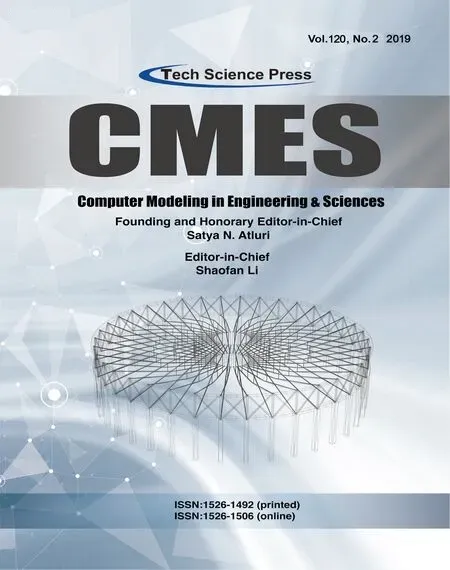Preface:Nano/Micro Structures in Application of Computational Mechanics
Chang-Chun Lee ,Nien-Ti Tsou and Taek-Soo Kim
1 Department of Power Mechanical Engineering,National Tsing Hua University,Hsinchu 30013,Taiwan.
2 Department of Material Science and Engineering,National Chiao Tung University,Hsinchu 30013,Taiwan.
3 Department of Mechanical Engineering,KAIST,Daejeon 34141,Korea.
Many important issues of structures,such as lattice mismatch,compatibility,orientation,evolution,phase transition,surfaces,interfaces,defects,and domain engineering,have attracted considerable interest.The corresponding mechanisms of these issues have not been fully elucidated.Computational mechanics has been widely used to investigate such complexities in nano/microstructures in recent decades.In this special issue,leading experts in their respective fields are invited to present their new insight into the theoretical calculation and modeling of nano/microstructures.Nine articles are collected.A brief introduction on each article is provided below.
In general,nano/microstructures are modeled by using various models,including finite element (FE) model,phase field model,constitutive model,molecular dynamics (MD),and ab initio model.Lee et al.[Lee and Huang (2019)] reviewed the applications of computational mechanics,such as atomistic continuum method,MD approach,and FE analysis (FEA),on the properties of nano/micro scaled thin films.The detailed simulated procedures of J-integral and modified virtual crack closure technique and related fundamental theories were introduced for common failure modes of interfacial delamination among stacked films.Several examples,such as the mechanical impacts on the mobility gain of strained nano-transistors and magnitude of bending stress induced in flexible OLED encapsulation architecture,were given to explain the suitable adoption of simulated approaches for acquiring reliable estimated results.Huang et al.[Huang and Williams (2019)] adopted J-integral and extended FE method (XFEM) to estimate the interfacial deflection energy release rates in multilayered structures under the lading type of four-point bending.The numerical results of linear elastic fracture mechanics and XFEM presented a good agreement with the analytical solutions.The predicted results indicated that the elastic modulus and thickness ratios significantly affect the interfacial cracking driving force for multilayered framework.Liu et al.[Liu and Chen (2019)] proposed a novel infinite element method (IEM) to solve plate vibration problems.Multiple layers of geometrically similar FEs,including the nodal data in boundary and the degree of freedom of the model,were considered in the concerned substructure domain.The determination regarding the inversion of symmetric,block-tridiagonal,and global stiffness matrix was implemented using the stiffness matrix of the first element layer.Several examples were provided to explain the advantage and numerical accuracy of the presented IEM.Lee et al.[Lee,Lo,Yang et al.(2019)] explored the thickness effect of nanocrystalline layer on the deformation mechanism of the mechanical strength and ductility of multilayered framework.Several material characteristics,such as stressstrain relationship,local stress,and local strain,of Cu64Zr36/Cu composites were considered.The stress-strain behavior of Cu64Zr36/Cu materials was dominated by the amorphous layer based on the estimation of an MD simulator,where the stress accumulated under the application of external load.Moreover,strain localization reduced the work on a crystalline layer with thin thickness when the stress passed the first yielding strain to achieve another yielding point.In the simulation analysis of biomedical microstructures,mechanical force plays a crucial role in the remodeling and degradation of cartilage tissues because it can generate,absorb,and transmit mechanical force and thus enables specific biological processes.Li et al.[Li and Chang (2019)] used full atomistic simulations with steered MD to determine whether the magnitude of mechanical force affects the unbinding pathway of MMP8-Aggrecan interglobular domain (IGD) complex.The major analytic results revealed that the mechanical force required to unbind Aggrecan IGD from MMP8 increases and a low pulling velocity is observed.Chen et al.[Chen and Tsou (2019)] investigated the thermal-induced phase transformation and microstructural evolution of Ni-Ti-based shape memory alloys by MD simulation.The above-mentioned characteristics are important when Ni-Ti alloys are applied in actuators and medical devices.Their analytic results indicated that different nucleated martensite patterns lead to different microstructural evolution paths.Clayton [Clayton (2019)] presented a theory invoking concepts from differential geometry of generalized Finsler space in conjunction with diffuse interface modeling.The foregoing concerned model was applied in the FEA of dual-phase polycrystalline ceramic microstructures.The major simulated results indicated that a composite with diamond crystals encapsulated in a nanocrystalline SiC matrix can enhance the strength and ductility compared with a two-phase composite with isolated bulk SiC grains.Yoon et al.[Yoon,Kang,Kang et al.(2019)] introduced a detection method for graphene cracks by electromagnetic induction.Their experimental results showed that defective graphene has higher induced voltage than pristine graphene because of the increase in inductance.This finding was demonstrated by a comparison between electromagnetic simulation and RF analysis.Additive manufacturing is considered a promising manufacturing method to overcome the difficulty during fabrication due to the complicated shape of nano/microscale devices.The deformation and stress concentration can be determined through the assistance of mechanics-based simulation.Lee et al.[Lee,Chen,Chen et al.(2019)] developed a layer-based mesh generator integrated with a corresponding scheme for 3D printing simulation.The above-mentioned simulated methodology enables the detection of failure mode location within the products and thus improves the printing results.
The developments and practical applications of computational mechanics and related simulated methodologies for nano/microstructures are still in progress.Many challenges should be overcome by researchers in related fields.This special issue only reflects the current status and trend.We look forward to many inspiring contributions from the authors in the future.
Acknowledgments:Sponsorship information:Publication of this supplement has not been supported by sponsorship.Information about the source of funding can be found in the individual articles.The peer review process was supervised by guest editors Chang-Chun Lee,Nien-Ti Tsou,and Taek-Soo Kim in accordance with peer review guidelines for special issues in Computer Modeling in Engineering &Sciences.
 Computer Modeling In Engineering&Sciences2019年8期
Computer Modeling In Engineering&Sciences2019年8期
- Computer Modeling In Engineering&Sciences的其它文章
- Numerical Treatment for Stochastic Computer Virus Model
- Modeling and Simulation of Dynamic Unloading of Prestressed Rockmass
- Simulation of Damage Evolution and Study of Multi-Fatigue Source Fracture of Steel Wire in Bridge Cables under the Action of Pre-Corrosion and Fatigue
- A Layer-Based Mesh Generator and Scheme for 3D Printing Simulation
- Detection of Graphene Cracks By Electromagnetic Induction,Insensitive to Doping Level
- Computational Modeling of Dual-Phase Ceramics with Finsler-Geometric Phase Field Mechanics
